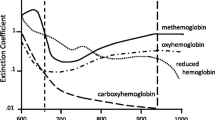Abstract
Interest in two-wavelength classic, that is, nonpulse, oximetry began early in the 20th century. Noninvasive in vivo measurements of oxygen saturation showed promise, but the methods were beset by several problems. The pulse oximetry technique, by focusing on the pulsatile arterial component, neatly circumvented many of the problems of the classic nonpulse arterial approach. Today's pulse oximeter owes a good measure of its success to the technologic advances in light emission and detection and the ready availability of microcomputers and their software. Many clinicians have recognized how valuable the assessment of the patient's oxygenation in real time can be. This appreciation has propelled the use of pulse oximeters into many clinical fields, as well as nonclinical fields such as sports training and aviation. Understanding how and what pulse oximetry measures, how pulse oximetry data compare with data derived from laboratory analysis, and how the pulse oximeter responds to dyshemoglobins, dyes, and other interfering conditions must be understood for the correct application and interpretation of this revolutionary monitor.
Similar content being viewed by others
References
Severinghaus JW, Astrup PB. History of blood gas analysis. J Clin Monit 1986;2:174–189
Merrick EB, Hayes, TJ. Continuous noninvasive measurement of arterial blood oxygen levels. Waltham, MA: Hewlett-Packard, 1976
Saunders NA, Powles ACP, Rebuck AS. Ear oximetry: accuracy and practicability in the assessment of arterial oxygenation. Am Rev Respir Dis 1976;114:745–748.
Cissick JH, Yockey CC, Byrd RD. Evaluation of the Hewlett-Packard ear oximeter for use during routine air transport of patients. Aviat Space Environ Med 1981;May:312–314
Douglas NJ, Brash HM, Wraith PK, et al. Accuracy, sensitivity to carboxyhemoglobin, and speed of response of the Hewlett-Packard 47201 ear oximeter. Am Rev Respir Dis 1979;119:311–313
Yoshiya I, Shimada Y, Tanaka K. Spectrophotometric monitoring of arterial oxygen saturation in the fingertip. Med Biol Eng Comput 1980;18:27–32
Cecil WT, Petterson MT, Lamoonpun S, Rudolph CD. Clinical evaluation of the Biox IIA ear oximeter in the critical care environment. Respir Care 1985;30(3):179–183
Chapman KR, D'Urso B, Rebuck AS. The accuracy and response of a simplified ear oximeter. Chest 1983;83:860–864
Pologe J. Pulse oximetry: technical aspects. Int Anesth Clin 1987;25(3):142–153
Wukitsch MW. Pulse oximetry: historical review and Ohmeda functional analysis. Int J Clin Monit Comput 1987;4:161–166
Gross J. Unprecedented rise in use of pulse oximetry reflects important advance in anesthesiology (interview). Anesthesiol News 1987;13(7):66,68–69
Southall DP, Bignalls S, Stebbens VA, et al. Pulse oximeter and transcutaneous arterial oxygen measurements in neonatal and paediatric intensive care. Arch Dis Child 1987;62:882–918
Taylor MB, Whitwam JG. The accuracy of pulse oximeters. Anacsthesia 1988;43:229–232
Scheller MS, Unger RJ. The influence of intravenously administered dyes on pulse oximetry readings. Anesthesiology 1986;65:S12
Sidi A, Paulus DA, Rush W, et al. Methylene blue and indocyanine green artifactually lower pulse oximetry readings of oxygen saturation. Studies in dogs. J Clin Monit 1987;3:249–256
Stewart RD. Carboxyhemoglobin levels in American blood donors. JAMA 1974;229:1187–1195
Barker SJ, Tremper KK, Hyatt J, Zaccari J. Effects of methemoglobinemia on pulse oximetry and mixed venous oximetry. Anesthesiology 1987;67:A171
Chaudhary BA, Burki NK. Ear oximetry in clinical practice. Am Rev Respir Dis 1978;117:173–175
Anderson JV. The accuracy of pulse oximetry in neonates: effects of fetal hemoglobin and bilirubin. J Perinatol 1987;7(4):323
Pologe JA, Raley DM. Effects of fetal hemoglobin on pulse oximetry. J Perinatol 1987;7(4):324–326
Yelderman M, New W, Jr. Evaluation of pulse oximetry. Anesthesiology 1983;50:349–352
Severinghaus JW, Naifeh KH. Accuracy of response of six pulse oximeters to profound hypoxia. Anesthesiology 1987;67:551–558
Payne JP, Severinghaus JW. Pulse oximetry. London: Springer-Verlag, 1986:29–30
Kagle DM, Alexander CM, Berko RS, et al. Evaluation of the Ohmeda 3700 pulse oximeter: steady-state and transient response characteristics. Anesthesiology 1987;66:375–380
Cecil WT, Morrison LS, Lamoonpun S. Clinical evaluation of the Ohmeda Biox III pulse oximeter: a comparison of finger and ear cuvettes. Respir Care 1985;30(10):840–850
Author information
Authors and Affiliations
Rights and permissions
About this article
Cite this article
Wukitsch, M.W., Petterson, M.T., Tobler, D.R. et al. Pulse oximetry: Analysis of theory, technology, and practice. J Clin Monitor Comput 4, 290–301 (1988). https://doi.org/10.1007/BF01617328
Issue Date:
DOI: https://doi.org/10.1007/BF01617328




